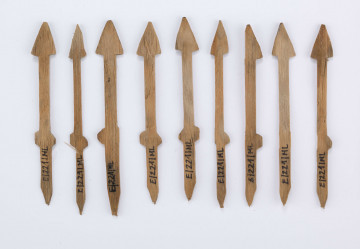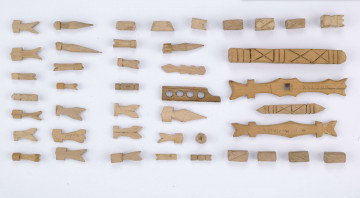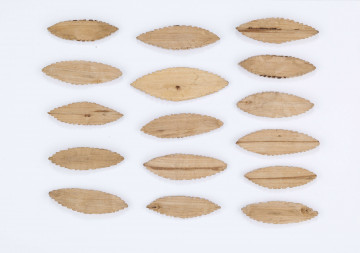
Game `Pick-up Sticks`
1901 — 1920
National Museum in Lublin
Part of the collection: Folk craft of the Lublin Region (19th/20th c.)
The rattle is hand-made from linden wood. Its maker and exact place of origin is unknown (the object came to the Museum in the first years of its existence, and its inventory card did not survive the war). It consists of two 24 cm-long and 6.5 cm-wide boards, one end of which is rounded. There are three holes in each of the boards. There are wooden sticks in the two square ones that support a thin raindrop touching the cogs, which are carved on a 12 cm-long handle placed in the third-round hole of the boards. The handle with the cogs is movable and, when turned, the board resting on the cogs, jumping from one mode to another, makes a rattling sound.
This prop was used only once a year, on Holy Thursday, when church bells were ‘tied up’ in the villages of Lublin and all over Poland, i.e., they were forbidden to be rung until the Resurrection. That was done as a sign of mourning, which was obligatory for believers on those days commemorating the death of Jesus Christ. In the past, villages believed that the sound of bells protected the inhabitants from misfortune and evil forces. It called for the Angelus, setting the rhythm of the day, announcing the time of religious services, informing of death and dangers that struck the village, such as fire or flood. When the bells fell silent, and the inhabitants were left unattended, the silence was broken by the sound of knockers, with which the boys would run around the village to ward off any danger.
Author / creator
Dimensions
cały obiekt: height: 24 cm, width: 6,5 cm
Object type
a ritual object
Technique
own
Material
lime tree wood
Creation time / dating
Creation / finding place
Owner
The National Museum in Lublin
Identification number
Location / status

1901 — 1920
National Museum in Lublin

1901 — 1920
National Museum in Lublin

1901 — 1920
National Museum in Lublin
DISCOVER this TOPIC
Museum of King Jan III's Palace at Wilanów
DISCOVER this PATH
Educational path